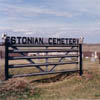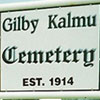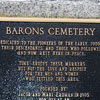Cemeteries
 Stettler-Big Valley's Estonian Chapel also featured an Estonian cemetery built in 1906. The local community appointed Hans Asberg the first undertaker as he was fluent in English. Joseph Tipman Jr. was the cemetery's secretary-treasurer and maintained burial records until his death in 2000. In 1907, there were three recorded burials. Reverend Sillak was adamant in his request to bury only Estonians in the cemetery. Anyone of non-Estonian descent was buried outside the cemetery. The property required proper enclosure and members of the community soon built a fence around the premises. In 1996, a trust fund was established for the perpetual care and maintenance of both the chapel and the cemetery. Beneath rows of iron crosses and beautiful headstones rest approximately 100 Estonian pioneers and their descendants: they provide testimony to the Estonian presence in the Stettler-Big Valley area.
Stettler-Big Valley's Estonian Chapel also featured an Estonian cemetery built in 1906. The local community appointed Hans Asberg the first undertaker as he was fluent in English. Joseph Tipman Jr. was the cemetery's secretary-treasurer and maintained burial records until his death in 2000. In 1907, there were three recorded burials. Reverend Sillak was adamant in his request to bury only Estonians in the cemetery. Anyone of non-Estonian descent was buried outside the cemetery. The property required proper enclosure and members of the community soon built a fence around the premises. In 1996, a trust fund was established for the perpetual care and maintenance of both the chapel and the cemetery. Beneath rows of iron crosses and beautiful headstones rest approximately 100 Estonian pioneers and their descendants: they provide testimony to the Estonian presence in the Stettler-Big Valley area.
 Inevitably the Estonian community living in the Medicine Valley required burial land. In 1903, a small plot of land on Charlie Raabis' property south east of Gilby was used as a cemetery. Otto Kingsep, visiting from Estonia, and father of Henry and Kristian Kingsep, was one of the first persons buried in this Cemetery. Within a few years it was abandoned in favor of the new Gilby (Kalmu) Cemetery and the orginal grounds fell into disrepair. The cemetery was rededicated during the Gilby Centennial in 2001.
Inevitably the Estonian community living in the Medicine Valley required burial land. In 1903, a small plot of land on Charlie Raabis' property south east of Gilby was used as a cemetery. Otto Kingsep, visiting from Estonia, and father of Henry and Kristian Kingsep, was one of the first persons buried in this Cemetery. Within a few years it was abandoned in favor of the new Gilby (Kalmu) Cemetery and the orginal grounds fell into disrepair. The cemetery was rededicated during the Gilby Centennial in 2001.
Estonian pioneers reconvened on 13 June 1913 to discuss the origins of the Gilby (Kalmu) Cemetery Company. Kalmu, in Estonian, refers to a resting place. The community strongly sought the establishment of a permanent resting place for friends and family. Members of the organizational committee included Mike Sestrap and Fritz Kinna. Minutes compiled during the meeting stipulated that all graves were to be elevated and a cross erected above each plot. Initially, plots sold for $8 but rose another $2 over the next few decades. Oscar Mottus constructed a 10-foot cross, painted black, to be erected in a central location in the cemetery. Volunteers gathered once a year to properly maintain and clean the cemetery. By 1977, the Gilby (Kalmu) Cemetery was the final resting place of 231 bodies; three decades later, it continues to serve the needs of the Medicine Valley community. The Estonian cemetery in Barons was rededicated in 2004.
 Jakob and Mari Erdman provided two acres of land to a cemetery for the Estonian and Finnish communities in 1905. In 1923 they donated the cemetery to the Village of Barons. The cemetery is located in the southeast quarter of Section 8, Township 12, Range 23, West of the 4th Meridian. In the meantime, many local residents have been buried here as evidenced by the tombstones and markers. Nevertheless, the cemetery fell into disrepair as two to three feet of soil drifted over part of the land during the dust storms in the dirty 1930s. Owing to the nearness of the Lethbridge Northern irrigation ditch the burial of bodies is not now permitted.
Jakob and Mari Erdman provided two acres of land to a cemetery for the Estonian and Finnish communities in 1905. In 1923 they donated the cemetery to the Village of Barons. The cemetery is located in the southeast quarter of Section 8, Township 12, Range 23, West of the 4th Meridian. In the meantime, many local residents have been buried here as evidenced by the tombstones and markers. Nevertheless, the cemetery fell into disrepair as two to three feet of soil drifted over part of the land during the dust storms in the dirty 1930s. Owing to the nearness of the Lethbridge Northern irrigation ditch the burial of bodies is not now permitted.
As part of the 2004 Barons Centennial Celebration of Heritage and Homesteading, a group of Barons-area pioneer descendants cleaned up the cemetery and provided a lovely arch and commemorative plaque. This is a wonderful legacy for future generations!








